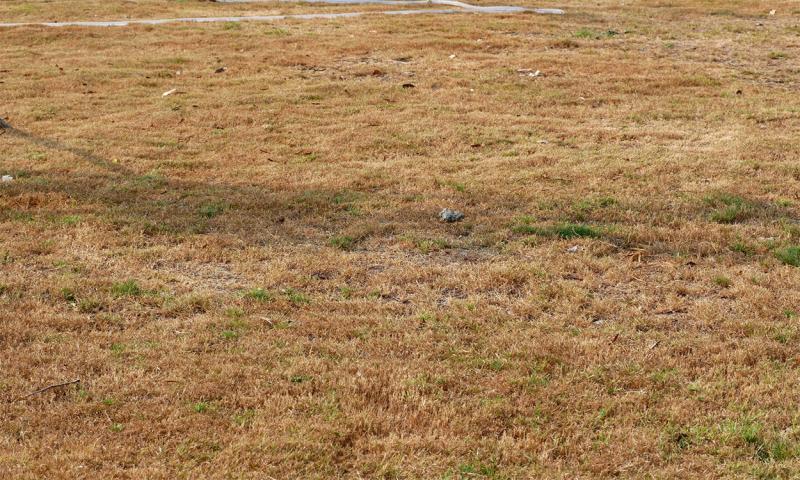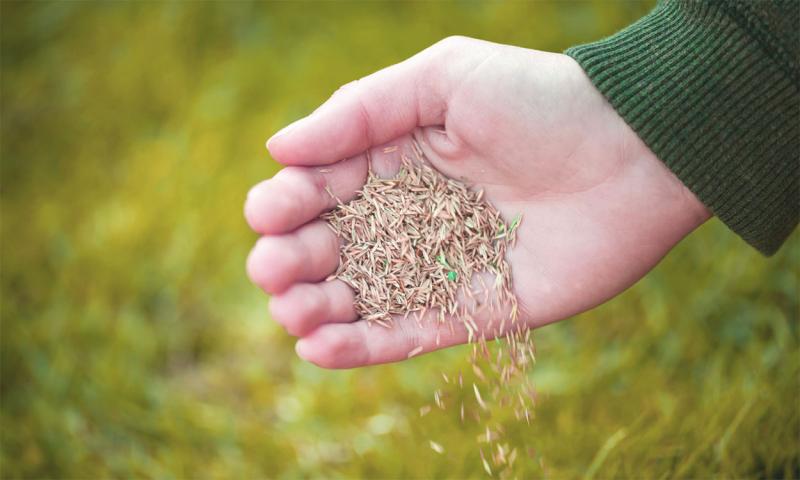
Written by Cindy Schnabel, SDSU Extension Horticulture Assistant and Master Gardener, under the direction and review of Brett Owens and Kristine Lang.
This year has been hard on all of our gardening efforts. This is especially true for your lawns. Those hundred-degree temperatures seemed to sap all the moisture out of the soil. In many cases, your lawn just did not go dormant, but some of it has likely died – leaving in its place brown grass, weedy patches and bare spots. The best practice to renew your lawn is a concept called overseeding.
Overseeding Cool-Season Grasses
Overseeding is a maintenance step that is important for a thick, healthy and weed-free lawn. Instead of getting upset that your lawn is thin or weedy in spots, this process will help you get a better-looking lawn without having to start over from scratch. Overseeding is nothing more than spreading grass seed over an existing lawn. This is the way golf courses maintain and achieve quality turf.
In our area, the grass that grows best is a cool-season grass: tall fescue, fine fescue, perennial and annual ryegrass and bluegrass. Mature lawns begin to slow down their reproduction rate, and young grass blades grow faster than older, more-mature ones. The best tip to creating a healthy lawn is to make sure your grass is young. Overseeding is the easiest way to make this happen.
The best time to overseed is late summer or early fall. In South Dakota, this means that you have to do some calculating. You need to know the first frost date in your area. For example, in the Aberdeen area that date would be September 22. Across South Dakota you can anticipate a frost event sometime between Sept. 21 to 30 in an average year. You should plan to overseed at least two weeks prior to the frost date to allow enough time for grass seed to germinate and start growing, so the time to overseed is Sept. 7 to 16.
Advantages of Overseeding
By seeding in the fall, you are giving your lawn a head start to survive the heat of the upcoming year. The advantages for seeding in the fall are:
- Fall reduces the competition from summer weedy grasses, like crabgrass.
- The warm soil speeds the germination of seed.
- The cooler air temperatures are better for grass growth.
- The grass has time to establish a good root system before temperatures drop to freezing.
- When spring arrives, the young plants will have another few months to establish deeper roots before the heat of the summer.
- Lastly, the rain amounts and soil moisture in general are better in the fall.
Aeration and Preparing the Soil
As you prepare to overseed your lawn, this is also the perfect time to core aerate. Core aerating is the process of pulling out a plug of grass and soil. You can go to your local equipment rental store and rent an aerator. A motorized core aerator will do the hard work for you. However, it is a heavy piece of walk-behind machinery, so it may take a bit of practice. Heavy rain or watering should precede aeration for effective core depth. Even the heaviest aerators will have a hard time penetrating the ground if it is dry. Do not worry about picking up the plugs. They will breakdown naturally. This process helps relieve compact soil problems.
A simpler way to aerate is called spike aeration. In this process, you will not be pulling out plugs of soil, but will simply punch holes in the ground. There are machines to do this too. But you can do this by putting a pair of spikes on, like football cleats, soccer cleats, golf shoes or lawn aerator sandals, which just strap on to your regular shoes. Then simply walk around your yard. How about just taking your potato fork and stabbing into your lawn? That will do the trick too. You are trying to help air and moisture reach the roots.
For grass seed to germinate, it must come in contact with the soil. The seed will not germinate if it is resting on debris, such as grass clippings, leaves, rocks or other material. To eliminate this problem, first mow your lawn to about three inches. This way you will be picking up any loose debris. If you still notice thatch (dry grass clippings), take a rake and remove what you can. That will allow the seed to contact the soil.
How to Overseed

You can overseed small areas or you can do your whole lawn.
If you are planning on doing a smaller area, it can be seeded by hand. The process is as easy as loosening the soil up and throwing seed out. Divide the seed you have in half. Spread the seed in one direction, then, broadcast the other half at a right angle to the first direction you did. This technique will give you the best coverage. As an alternative to hand seeding, you can purchase a small hand rotary seeder. These are generally inexpensive and spread the seed more evenly than sowing seed by hand.
For larger areas, it is better to use a drop or rotary spreader. You can use the same one that you fertilize with. Drop spreaders are more accurate when working around flower gardens, sidewalks and ponds. A drop spreader will drop the seed at precisely the same width all over. You have to be sure you are walking in a straight line. Any swerving will result in missed areas. Don’t forget to do a second pass at a right angle to the first. You want the best coverage you can get. A broadcast spreader will cover three to four times the width of the spreader. Remember that the seed is lighter than fertilizer, so it will not broadcast as far as fertilizer does. Keep in mind that it could clog too. Also, if it is windy, you need to compensate for that too.
With the seed down, you need to make sure the soil stays moist. This helps the seed germinate. This could mean you are watering every day. If the temperature is high, it may dry out the soil, so you need to water it again. Once the grass starts sprouting, you can gradually reduce irrigation to match normal watering schedules.
Overseeding your lawn is a good maintenance procedure and a great way to renew your lawn. This year with the drought, it will help bring back your turf. The fall timing gives you the best conditions for new grass to grow and thrive. The overseeding process is an easy way to create and maintain a healthy, vibrant lawn.


